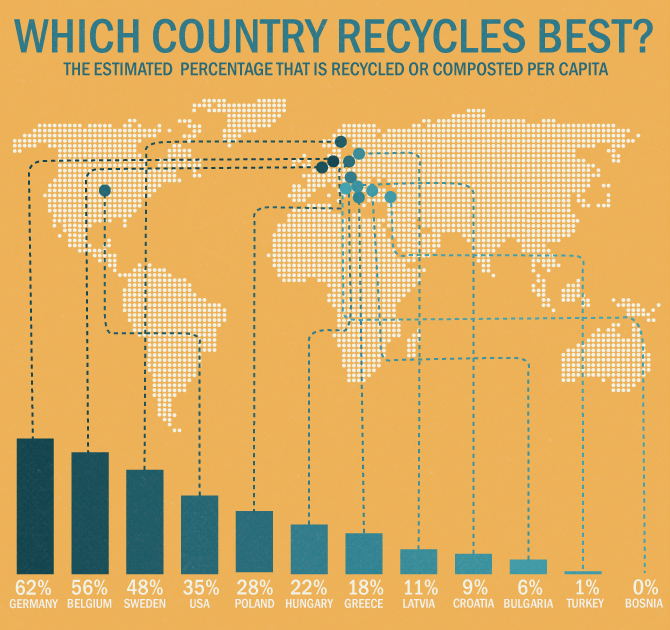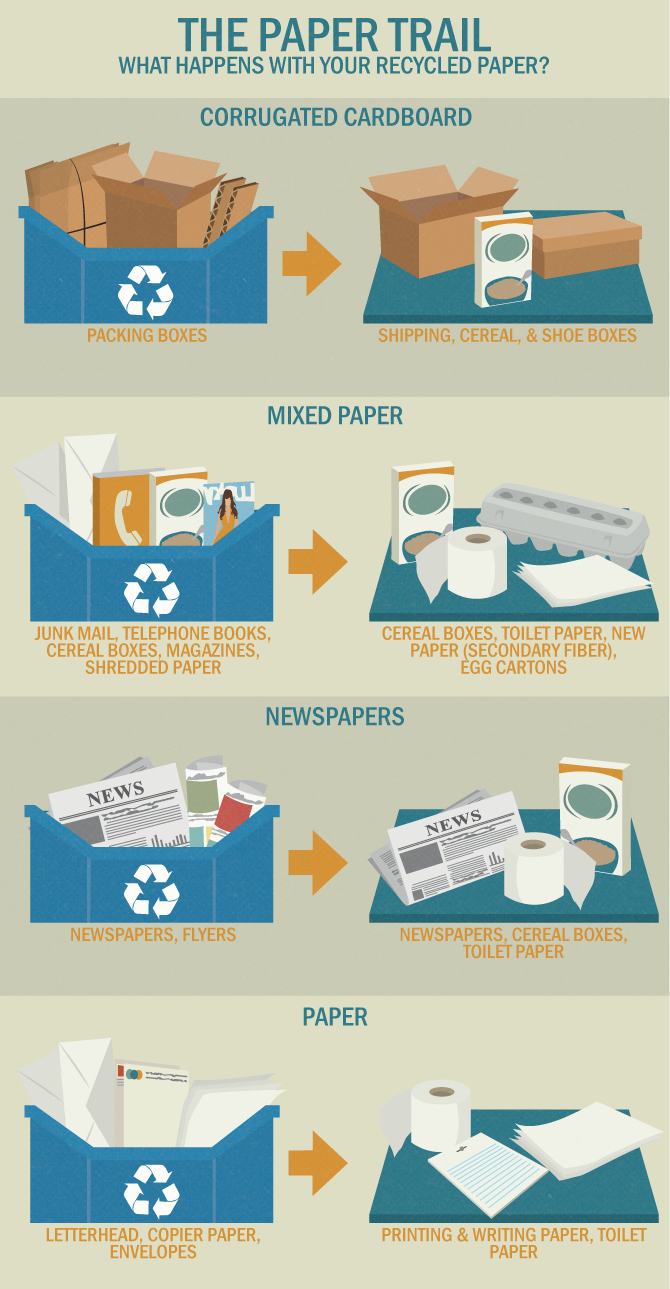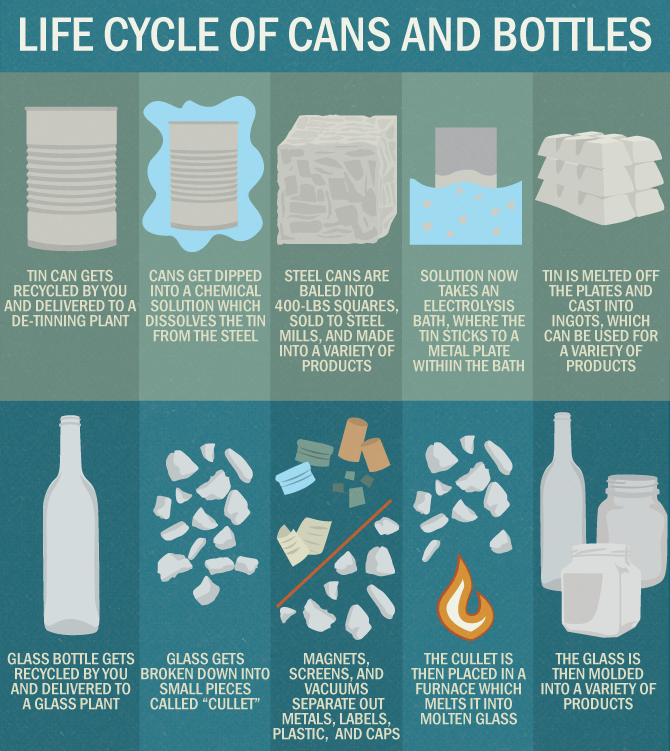Recycle Me This
Be a Better Recycler
I’ve lived in six cities in four countries in the last five years, so moving has become a near-yearly event! But after that initial excitement and hustle and bustle of moving to a new city, I’m always left with a big pile of boxes, packaging and fast food containers and no earthly idea of how to properly dispose of it all. In a perfect world everything would be recyclable and the rules for blue bins and green boxes would be the same around the world. But the reality is that political and financial concerns can prevent some countries from having a recycling program at all, and those that do have varying success in diverting the amount of municipal waste their citizens produce.

Even within a country, every single municipality’s recycling program is different. Why is that? And are there some universal do’s that can make that moving mess more manageable?
MRF’s Up!
Household recycling started in earnest in the 1980s, but recycling facilities weren’t pop-up, cookie-cutter, ready-to-go factories. There were growing pains as technologies and collection processes developed. Then and now, the materials accepted by your nearest MRF (materials recovery/recycling/reclamation facility – pronounced “murf”) vary with two things: supply and demand.
Like any other business, recycling has to be efficient and profitable to be sustainable, So MRFs focus on materials for which there is a substantial and consistent supply and a healthy market for the recycled end product. Both of these factors depend greatly on the size and location of the facility. Is it low- or high- capacity? Is it in North America or Europe? Is it near to, or far from, an urban center? Are its citizens eager or reluctant recyclers? All these considerations make for a mosaic of MRFs with different specialties, and different processes.
Sorting it Out
Early recycling programs had residents pre-sort materials because that made it a simpler and cleaner process at the MRF, but as technologies have improved, municipalities came to see the benefits of single-stream (throw-it-in-the-bag) recycling. When residents don’t have to sort, they recycle more and collection becomes more efficient: one bin, one truck. But there’s always a trade-off: what happens when you release residents from the burden of sorting? We go all in.
Are You a Bad Recycler?
We tend to feed our eco-egos by feeding our blue bags. And while it’s somehow reassuring to see those plump bundles bursting at the seams, there is such a thing as being a bad recycler. If our bags are bursting at the seams with broken wine glasses and moldy cheese, we’re missing the mark. Our thinking about recycling can be just as mushy as the sludge in our bins. So let’s keep it simple and look at the basics.
Paper
Paper is typically made from trees and grasses, which makes it inherently biodegradable. However, we modify and add to paper to serve our different needs. Adhesives, staples, plastic windows, metal strips, and ink make paper useful as envelopes, cereal boxes, packing boxes, magazines, and sheet music. How do these modifications affect recyclability? Well, the technology is such that most of these modifications can usually be dealt with by either the MRF itself or the purchaser who actually recycles the product. Food and oil-stained paper, however, and plasticized paper (if you rip the paper and there’s a layer of thick plastic inside or outside) are more problematic. The garbage is the best place for those.

Plastic
Plastics are petroleum products. Even though petroleum is formed from dead organisms (mostly algae and zooplankton, if you’re curious), its products are not readily biodegradable – but most are now recyclable. Different plastic resins meet our needs for durability, flexibility, strength, elasticity, opacity, and weight, but they also have different fates in the recycling process. In 1988, plastic manufacturers added numbers to plastics to help improve sorting, and keep plastics heading down the right stream toward recycling and not into the landfill. Plastics recycling varies most between MRFs, so make sure you know exactly what your facility can process.

Glass
Glass is one of those simple, but wonderful products. Besides being sturdy, heat-safe, durable, washable, and reusable, it is infinitely recyclable! It simply needs to be color-sorted, washed, crushed, melted and reformed to rejoin the world. No loss in quality whatsoever. But, this infinite recyclability only applies to standard glass bottles and jars, which melt at the same temperature, and not glassware, Pyrex, ovenware, mirrors, or windows. Also, be wary of broken glass, which is dangerous for workers. All broken glass – even from jars and bottles – should be sealed up or wrapped in newspaper and placed in the garbage.
Metals
Metal is another great reusable product. Like glass, metals can be cleaned, melted, and reformed, which is particularly useful because mining for raw materials is wasteful and increasingly costly. Steel and aluminum are the two most common metals you’ll find in your household and they’re the two most recycled metals in North America.

The Other Stuff
Lightbulbs, keys, DVDs, corks, tires, toys, sunglasses, batteries, appliances, windows – many items in our households don’t fit the paper/plastic/glass/metal mold. But that doesn’t mean they belong in the trash. Look up specialty recyclers that will take things like electronics and batteries, check out Recycle This for tips on recycling or reusing items, or join The Freecycle Network to find people in your area who will take nearly anything off your hands! Recycling is wonderful, but it should always come after reducing and reusing. And don’t forget about composting!
The “Do” List
Despite the diversity of curbside recycling programs around the world, there are some universal recycling do’s that apply wherever you live.
- 1. Rinse it. But don’t go nuts. Scrape away food scraps and give containers a good rinse in cold water. Food-contaminated containers have a lower market value, and they can invite pests to your storage area. All products will get cleaned and sterilized during the recycling process, so no need to waste hot water or dishwasher space on these.
- 2. Crush it. Transportation costs are high, so it’s wasteful to pay through the nose to transport milk- or juice-scented air. Crushing containers is always a good idea and offers a brief foot massage and some stress relief.
- 3. Leave it out. The recycling is not a dump for all things you hope are recyclable, think are recyclable, or were recyclable in the last five cities you lived in. If you’re not 100 percent sure about an item, check the fridge chart from your town or contact your municipality’s information line and find out. As you target questionable items one by one, you’ll gain confidence in your recycling know-how and overcome any lingering habits from the past.
As citizens, it’s our job to keep up-to-speed as recycling facilities integrate new technologies and work towards sustainable recycling. So read your municipality’s recycling guide with care and expect it to change every year. By simply following the “do” list, you’ll be contributing greatly to the efficiency and safety of the recycling process, no matter what color your bags, bins, and boxes are.
Embed the article on your site

